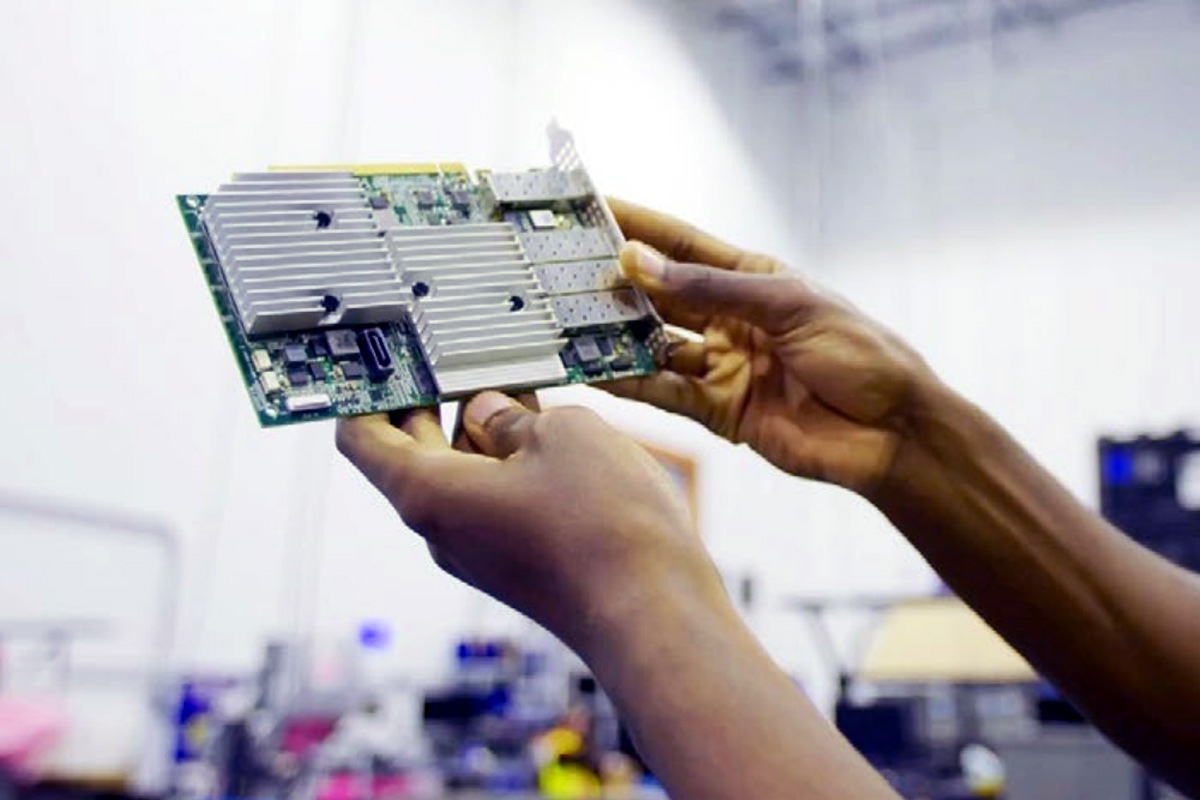
An Amazon worker at a reverse logistics hub holds a piece of data center equipment | Amazon
Amazon’s large-scale data center decommissioning facility coming to Pennsylvania will be a “huge part” of the company’s sustainability drive, which focuses on reusing and remanufacturing as much as possible, a company representative said.
Amazon recently announced that it’s working to build a 550,000-square-foot data center decommissioning/ITAD facility in Greencastle, Pa., a three-hour drive west of Philadelphia. The facility will be run by a newly created standalone company under the Amazon umbrella called re:Cycle Reverse Logistics.
“The company specializes in the handling of valuable electronic equipment like servers used in data centers,” Lisa Anderson, spokesperson for re:Cycle Reverse Logistics, said in a statement to E-Scrap News. “Its services are designed to maximize the useful life of electronic equipment, develop more sustainable and efficient recycling practices, and handle electronics in an environmentally-sound manner.”
Re:Cycle Reverse Logistics is an outgrowth – and large scaling up – of the existing reverse logistic operation that’s a division of Amazon Web Services (AWS), the massive data center operator and cloud services provider, said another Amazon representative who preferred not to be named.
The representative said re:Cycle Reverse Logistics will initially focus on processing AWS data center equipment, not the company’s office electronics. The representative suggested the company could take on clients outside of Amazon in the future.
Hundreds of staff and vendor employees on site
Amazon will lease a space in a relatively new building at 121-123 Commerce Ave. in Greencastle. The company is still going through the permitting process, with an expectation the facility will begin operating in 2024.
This fall, the company will begin placing listings for jobs and go through the initial rounds of hiring, the representative said.
Anderson’s statement noted that between re:Cycle Reverse Logistics staff and employees of third-party vendors, the facility is projected to generate 300 to 500 jobs at peak operation, which should occur within three years.
At the facility, staff will disassemble equipment and sort and test components, the representative said. Some material will be prepared for reuse internally by Amazon, and other components will be sent off site to another remanufacturing facility. End-of-life electronics will be taken to another facility for recycling, the representative said.
The Amazon representative was not able to answer questions about which vendors are involved in AWS data center decommissioning now or after the Greencastle facility opens.
Strategy to extend equipment life
Although Amazon doesn’t disclose details on the scale of AWS, including any data on the number of racks or servers it decommissions, the company’s latest annual financial report shows it tallied net sales of $22.1 billion during the second quarter of this year. Its operating income was $5.4 billion. It’s smaller than the company’s e-commerce businesses in terms of revenue, but it tends to be quite a bit more profitable.
Amazon’s latest sustainability report also details the role AWS’ existing reverse logistics hubs, which are located in the U.S. and Ireland, play in helping the parent company meet its sustainability goals. Each hub has an ITAD center and a failure analysis lab that tests and repairs used components.
Those sustainability goals include reducing the carbon footprint of data centers by extending equipment life. The report notes that its existing reverse logistics hubs, which take in all of AWS’ functional, sanitized and retired server racks and components, “help us consolidate, assess and recirculate functional equipment back into our inventory.”
Obsolete and end-of-life equipment is wiped of data and either sold on the secondary market or sent to recycling vendors.
Amazon has also increased server lifespans, including by changing software to run more efficiently, which reduces stress on hardware, according to the sustainability report. Last year, the company extended its estimate of AWS server life from four to five years and networking equipment life from five to six years.
The change doesn’t just yield environmental benefits; it has accounting ones. The company’s annual report for 2022 noted that the life extension was attributable to “continuous improvements in our hardware, software, and data center designs.” Adding a year to the life of each category of equipment reduced Amazon’s depreciation and amortization expenses for 2022 by $3.6 billion.

